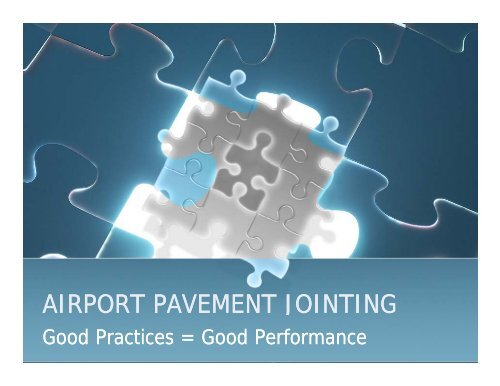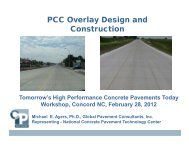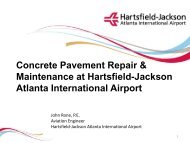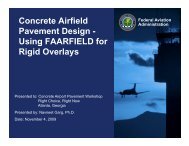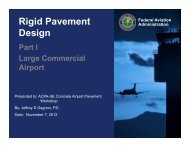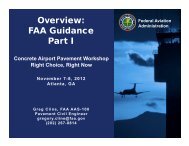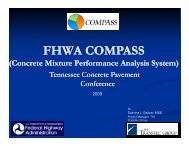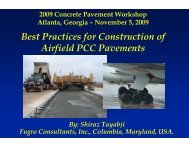airport pavement jointing - American Concrete Pavement Association
airport pavement jointing - American Concrete Pavement Association
airport pavement jointing - American Concrete Pavement Association
You also want an ePaper? Increase the reach of your titles
YUMPU automatically turns print PDFs into web optimized ePapers that Google loves.
AIRPORT PAVEMENT JOINTINGGood Practices = Good Performance
Airport <strong>Pavement</strong> JointingGreg DeanDirector of Airports<strong>American</strong> <strong>Concrete</strong> <strong>Pavement</strong> <strong>Association</strong>Southeast ChapterGDEAN@PAVEMENTSE.COM919.772.6648www.<strong>pavement</strong>se.comOctober 21, 2008
A Cost-Effective <strong>Pavement</strong>That Meets / ExceedsAnticipated Design Life
Over-Designing is not the answerMore is not always better…• Extra Thickness• Extra Strength• Extra Reinforcement or Dowels• Extra Base (Depth or Strength)Good Jointing practices will lead to goodperformance
Less than 1 year Old…Design Issue?Construction Issue?Combination?
Good Designs = Good PerformanceConstructed in 1953PCI = 97Brunswick – Golden Isles
Good Designs = Good Performance<strong>Concrete</strong> vs. AsphaltForty years older than AsphaltBQK <strong>Pavement</strong> Performance ComparisonAsphalt<strong>Concrete</strong>PC CI Rating1009080706050403020100979695 96.497067.8364Apron RW TW Total
Why the difference?McKinnon – St. Simons IslandApron PCI = 20Shattered slabs
Performance – Why thedifference?• Similar Materials• Similar Thickness (10”)• Similar Base (stabilized)• Similar il LoadingPCI = 9712.5 x 15 feetVery differentJointing PatternPCI = 20~ 25 feet
Principles of DesignLoad stressTCurling and WarpingVolume ChangeJointSpacing
Jointing Purpose• Limit slab stress• Construction increments• Allow slab movement• Provide load transfer• Provide crack that can be maintained
Crack Formation-3/8 in.100 ftDrying Shrinkage-3/8 in.Thermal ContractionRestraintRestraintCurling/Warping± 20 ft
Shrinkage (cycle)Curling: caused by temperature gradientWarping: caused by moisture gradientCool Top/dryingWarm Top/wetting
What Causes Curling?DayTensionCoolHotWeight of slabNightCompression
Crack Formation-3/8 in.100 ftDrying Shrinkage-3/8 in.Thermal ContractionRestraintRestraintCurling/Warping± 20 ft
Where Does Restraint Come• SubbaseFrom?• Friction (higher the stiffness > restraint)• Unevenness• Voids• Slab edges (fill-in lanes)• Friction• Dowel bars or tiebars
Solution is Controlled Cracks(Joints)• Spacing & type• Vertical work• Thickness• Shrinkage• Load transfer req’t• Steel content• Base material(<strong>pavement</strong>s)• EOR specify jointlocation/type• <strong>Pavement</strong>s• Specify spacing &type but be flexibleof location• Depends onconstruction methods
Considerations for Jointing• Joint Spacing• Joint Type• Dowels• Sealing
FAA Maximum Joint SpacingSlab ThicknessTrans.Long.60 6.07.0-9.09.0-12.0>12.0inch12.512.515.0 15.020.0 20.025.0 25.0feetFAA AC 150/5320-6D Table 3-11
Stabilized or OverlayML = T x CSSlab ThicknessTrans.Long.60 6.08.010.0>12.0inchMax10.00 12.512.5 12.515.0 12.520.0 20.0feetML = Max. Length between jointsT = Slab ThicknessCS = Support Constant• Use 24 for granular subbases• Use 21 for stabilized oroverlays
Joint Types• Contraction (Shrinkage or Control)• Construction
Contraction Joints
Contraction Joint DetailsDoweledPlain
Jointing Begins With A SawcutGranular SubbaseStabilized Subbase• T/4 Saw Depth• T/3 Saw Depth• Bond BreakerOther Considerations:• Saw Timing• <strong>Concrete</strong> AggregateLimestoneSiliceous GravelTemperature Sensitivity
DoweledConstructionJoints
Construction JointSmooth DowelSeal ReservoirT/2TSmooth Face (Butt Joint)
Dowel Hole Gang Drill
Doweled Contraction JointsDoweled
Airport Dowel DimensionsSlab Thickness Dia. Length. Space6.0-7.080-12 8.0 12.013.0-16.017.0-20.0021.0-24.0inches0.7510 1.01.25150 1.502.0018.018.020.020.0024.0inches12.012.015.018.018.0
Where to Use Dowels...• Longitudinal construction Joints• Certain transverse expansion joints• Last 3 transverse contraction ti jointsfrom free edge (i.e. runway ends)AC 150/5320-6D339. Jointing Steel: Where used. Provisions for loadtransfer by dowels is provided at all transverse expansionjoints and all butt-type construction joints. Dowels forcontraction c o joints should be provided at least three jointsfrom free edge. Contraction joints in the interior may be thedummy groove type (type H).
Isolation/Expansion JointsDoweledCapThickenedEdge1.25TFiller
Isolation Joints• Separate <strong>pavement</strong> segments ofdissimilar movement (axis)• use bird’s eye view• Where future <strong>pavement</strong> might beexpected• At <strong>Pavement</strong> Penetrations
Where to Isolate...DifferentMovementAxis
<strong>Pavement</strong> Penetrations
Filets...
Filet DetailsThickened Edge JointPerpendicularto edge2 ftOptional Location
Odd-shaped Panels in Filets• Add steel reinforcement (mesh)• 0.05% by cross-section in bothdirections minimum
Fillet Details
Joint Layout PatternConnectorIsolationDoweled ContractionDoweled ConstructiontiRunwayContractionTaxiway
Don’ts
Construction Joint DetailsSeal ReservoirKeyedT/2TFAA AC/150-5320-6D - Do not use for <strong>pavement</strong>FAA AC/150 5320 6D Do not use for <strong>pavement</strong>less than 9-inches. Not recommended for use at<strong>airport</strong>s with wide-body traffic.
Bad Male Keyways
Don’t bringa joint tothe edgeof<strong>pavement</strong>on anangle
Don’tplacebars tooclosetogether!
Don’tdrill adowelhole intoanotherjointface
Summary• Watch your panel size (smaller isbetter)…especially with stiffer, highfriction support/bases• Ideally, be square• Keep ratio (slab L : slab W) to 125%• Look for opportunities to optimize:• Paving lane widths…be flexible• Aggregate interlock has provenperformance for airfield <strong>pavement</strong>s
Thank YOUGREG DEANDirector of Airports<strong>American</strong> <strong>Concrete</strong> <strong>Pavement</strong> <strong>Association</strong>Southeast ChapterGDEAN@PAVEMENTSE.COM919 772 919.772.6648www.<strong>pavement</strong>se.com
Temp Effects on VolumeChangeTemperaturePlastic Autogenous DryingEvaporation Emptying py of Capillaries DryingTime
Load stresses in rigid<strong>pavement</strong>• Temperature• Creep & Shrinkage• Curling & warping• TrafficTraffic LoaddyEh23 2M = EIM =22dx12 (1 − μ2 )dxMoment – CurvatureEquivalent to(Beam)Moment – Curvature(Slab)dw
W3l2l1ll=4Eh3212 (1 − μ)k


